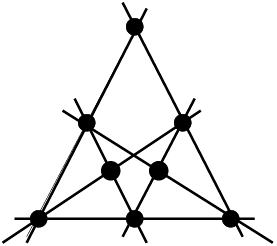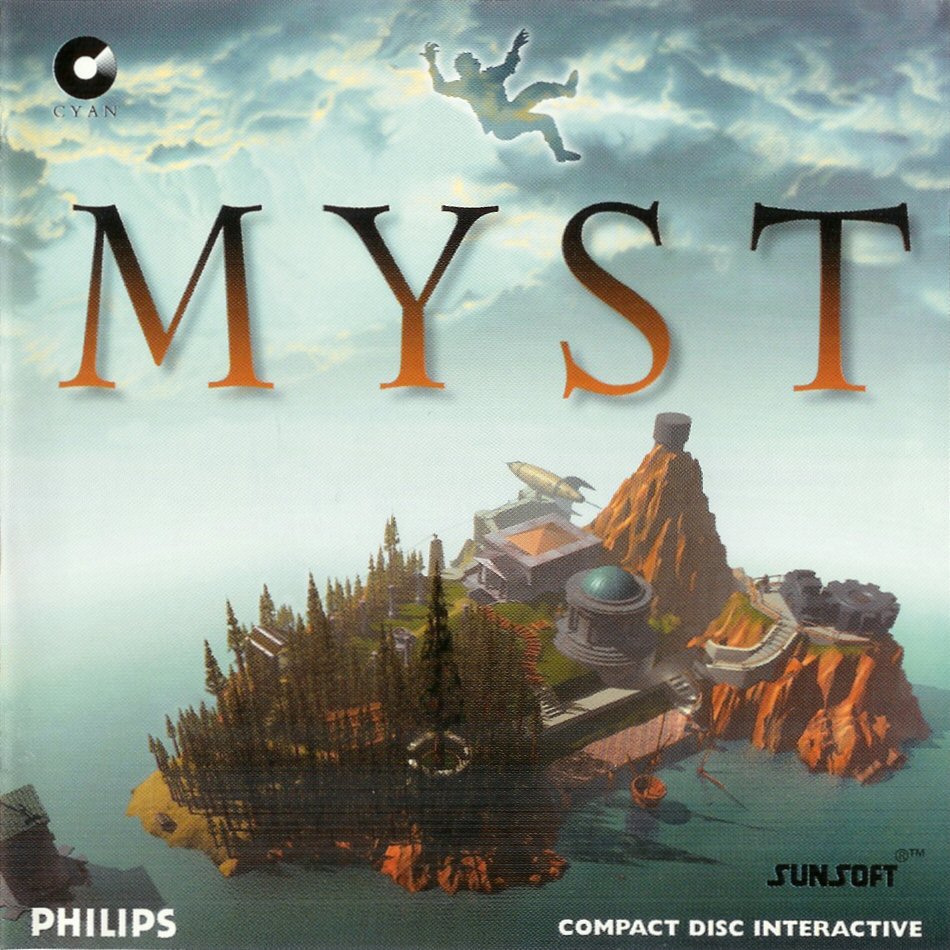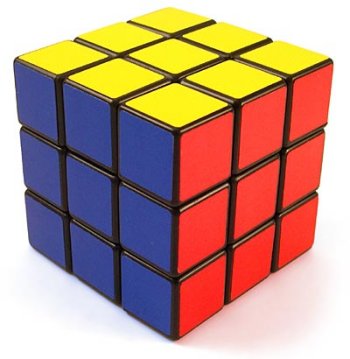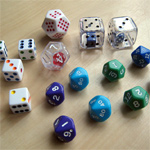
Willamette University Department of Mathematics
2007-2008
Fall Semester
Tuesday, September 18, 4:00pm
Prof. Inga Johnson, Willamette University
Planting Trees
Abstract:
Your aid I want, nine trees to plant
In rows just half a score;
And let there be in each row three.
Solve this: I ask no more.
The puzzle above was published in 1821 by John Jackson in a book of problems
called Rational Amusement for Winter Evenings. We'll talk about the
solution to this puzzle (try to figure it out before the talk!) and the
following generalization:
Given a positive integer p, how can p points be arranged on a
plane, no four in a straight line, so that the number of straight lines with
three points on them is maximized?
We'll discuss known solutions and some accessible open problems (which there are
many) all stemming from a question about planting trees!

Thursday, October 4th, 4:00pm
Collins Room 204
Prof. Josh Laison, Willamette University
Count on the Platonic
Solids
Abstract:
Platonic solids are the three-dimensional analogs of regular polygons in two dimensions. They have been admired for thousands of years for their beauty and symmetry. The numbers of distinguishing features of these polyhedra, such as the number of vertices, edges, and faces, and even the number of Platonic solids, contain many interesting patterns, and they get even more interesting in higher dimensions. We'll investigate some of these patterns, and spend some time counting on the Platonic solids.
Rated: PG





Wednesday, October 10th, 4:00pm
Collins Room 204
Prof. Liz Stanhope, Lewis & Clark College
Doughnuts sound good to
me!
Abstract:
Suppose you made a drum that was in the shape of a doughnut. You could
then strike this drum and listen to how it sounds. Would it be possible
for doughnut-drums of different sizes to sound exactly the same? One way
to tackle this question is to go to higher dimensions. Another way is to punch
more holes in the doughnut.
We'll do both and see what the resulting doughnuts have to say.
Rated PG13
Tuesday, October 16th, 4:00pm
Collins Room 204
Prof. Gary Gislason, Willamette University
Some Properties of the
Sum and Product of Two Uniformly Distributed Random Variables
Abstract:
In this presentation the density and cumulative distribution functions of both V=X+Y and V=XY will be developed. The random variables, X and Y, are taken to be uniformly distributed on [0,1].
Rated PG13
Thursday, October 25th, 4:00pm
Collins Room 204
Prof. Peter Otto, Willamette University
Is the Sacrifice Bunt a Good
Baseball Strategy?
Abstract:
The sacrifice bunt is often used by baseball managers as a strategy to score runs by putting runners in scoring position at the "sacrifice" of losing an out. In this talk, we'll look into the value of this strategy by modeling baseball with a very useful tool in probability theory called Markov Chains.
Rated PG

Thursday, November 1st, 4:00pm
Collins Room 204
Prof. Jessica Sklar, Pacific Lutheran University
Defeating the Robot and Unlocking Doors: Mathematical Solutions to Computer Game Puzzles
Abstract:
Many puzzles in computer adventure games are obviously mathematical; others are math problems in disguise. In this talk, we discuss the use of linear and abstract algebra to solve puzzles in computer games such as Myst and Timelapse.
Rated PG

Thursday, November 15th, 4:00pm
Collins Room 204
Professor Emeritus Richard Iltis, Willamette University
An Historical View of Models for Planetary Motion
Abstract:
We follow the development of mathematical models for the movement of planets beginning with the Greek quest for harmony in the universe as exemplified by uniform circular motion. Scientists who contributed major insights include Ptolemy, Copernicus, Kepler, Newton, and Einstein. The models begin with spheres centered at the earth and continue to ellipses about the sun.

Tuesday, December 4th, 4:00pm
Collins Room 204
Prof. Erin McNicholas, Willamette University
Abstract:
Mathematical Toys: the Rubik's Cube and
other permutation puzzles
Abstract: We'll examine the Rubik's Cube group, which is made up of all
possible configurations of the cube. Using group theory to analyze this
set, we'll determine some interesting properties of the cube. Which
transformations of the cube commute with all others? How many moves on the
cube does it take to get it into a particular configuration? What are the
most common solution techniques? We'll look at a few other permutation
puzzles that can be analyzed in a similar way. If you have a Rubik's cube
handy, bring it! You'll have the chance to try out a few moves and master
the superflip.
Rated: PG 13

Spring Semester
Thursday, January 24th, 4:00pm
Collins Room 204
Professor Holly Swisher, Oregon State University
Monstrous Moonshine Meets Rogers-Ramanujan Functions
Abstract:
Some of the most fascinating mathematics
occur when seemingly unrelated objects reveal themselves to be distinctly
intertwined. In this talk we will see a surprising connection between the
Monster, the largest finite
sporadic simple group, and Rogers-Ramanujan functions, which are connected to
Ramanujan's famous continued fraction.
One of the many things Ramanujan did in his life was to list 40 identities
involving what are now called the Rogers-Ramanujan functions on one side, and
products of functions of the form $\prod_{n=1}^\infty (1-q^{mn})$ on the other
side. It was remarked by Birch that these identities seemed too
complicated to guess, even for one with Ramanujan's incredible instinct for
formulae. Recently however, Koike devised a strategy for finding (but not
proving) these types of identities by noticing an interesting connection to the
Monster. He was able to conjecture many new Rogers-Ramanujan type
identities which we have now proved. The key to tying it all together?
Modular forms!
Rated R
Thursday, February 21st, 4:00pm
Collins Room 204
Professor Stephanie Salomone, University of Portland
Analyzing a Multi-Scale Symphony
Abstract:
Wavelets have applications in many fields
of science and
mathematics, including noise reduction, mammography, fingerprint analysis, and
other forms of data storage and compression. Recently, wavelets were used to
predict forgeries in works of art. Because of their ability to localize and give
a time-frequency description of a signal, we can use wavelets to decompose,
compress, and resynthesize a signal accurately and with little loss of
information.
We will discuss the symphony analogy for the wavelet transform, an accessible
heuristic that describes how we might decompose a signal using wavelets. We'll
also construct a basis for an infinite dimensional vector space, and talk about
uses of wavelets in pure mathematics.
Rated PG
Thursday, February 28st, 4:10pm
Collins Room 204
Professor Ellen Gethner, University of Colorado at Denver
An Adventurer's Guide To The Treasure Hunt For High Chromatic Thickness-Two Graphs
Abstract:
A graph
G is said to have thickness-t if the edges
of G can be partitioned into t and no fewer planar
graphs. For example, if G is planar, then G has thickness-one. For
another example, with the help of Kuratowski's
Theorem, it is easy to see that K5
has thickness at least two. A
longstanding open problem is the following:
The
largest chromatic number of any thickness-two graph is known to be one of 9, 10,
11, or 12. The 9 is due to
exactly one published example of a 9-critical thickness-two graph found by Thom
Sulanke in 1973 and was reported by Martin
Gardner in 1980. The 12
is due to a straightforward argument that relies on Euler's
Formula for planar
graphs.
We introduce a catalogue of new small 9-critical thickness-two graphs, and a
construction that generates infinitely many 9-critical thickness-two graphs,
thus providing ballast to the 9,
and providing a stepping stone to the search for a 10-chromatic thickness-two
graph as well. In addition new families of thickness-two graphs will be defined,
some of which have a known asymptotically sharp upper bound for the chromatic
number.
The (re)search for the thickness-two 10-chromatic graph is a continuing treasure
hunt and this talk will highlight many of the gems that have been found so far.
http://carbon.cudenver.edu/~egethner/WillametteUniversity_EllenGethnerTalk.html

Thursday, March 6th, 4:10pm
Collins Room 204
Alex Jordan, University of Oregon
An Introduction to the Riemann Zeta Function
The Riemann zeta function is very curious.
It's definition is relatively simple to write down, but a full understanding of
its properties remains elusive. The famous Riemann Hypothesis makes a
conjecture about where the function's zeros lie, and a virtual library of
published theorems use the Riemann hypothesis as an assumption. This is
one reason why a proof of the Riemann Hypothesis is considered by some to be the
biggest unsolved problem in mathematics.
We'll introduce the function and discuss well-known basic properties -
especially its connection to the Gamma function. Mathematica generated
pictures will hint at the truth of the Hypothesis, but also hint at difficulties
in proving it. There is a connection between the zeros of the function and
prime numbers that we will look at. If time allows, we'll look at one or
two examples of theorems that use the Hypothesis as an assumption.
Tuesday, March 11th, 4:10pm
Collins Room 204
Cam McLeman, University of Arizona
Generating Functions and some Crazy Dice
Number theory, and mathematics in general, is filled with interesting sequences of numbers -- square numbers, powers of two, prime numbers, Fibonacci numbers, etc. Unfortunately, one typically has to invest in a course (or a lifetime) in number theory to make any progress on questions surrounding these sequences, but we'll describe a simple technique -- "hanging your sequence on a clothesline" -- which lets you get lots of cool number theory out of basic Taylor expansions and the factorization of polynomials. As a particularly surprising example, we'll expose critical information on board games that the powerful Washington dice lobby doesn't want you to know...

Thursday, March 20th, 4:10pm
Collins Room 204
Meike Niederhausen, University of Portland
How does a Mathematician get a Nobel
Prize?
or
An Introduction to Mathematical Finance and Option Pricing
Abstract:
In this talk we will introduce the basics of mathematical finance. In particular
we will discuss how to price a European option, which is a
certain type of financial derivative. Options allow investors to hedge losses in
the stock market by capping how much they will be able to buy or sell a stock
for in the future. We will start out with using the discrete time binomial tree
to model stock prices and derive a formula
for the fair price of an option, which will then be generalized to a continuous
time model which uses Brownian motion to model stock prices. This
will lead us to the widely celebrated Black-Scholes formula, for which Fischer
Black and Robert Merton received the Nobel Prize in Economics in 1997.
PG: 45% G, 35% PG, 10% PG13, and 10% R
Tuesday, April 1st, 4:00pm
Collins Room 204
Prof. Tim Chartier, Davidson College
Improving on your Mistakes: solving
linear systems iteratively
Abstract:
Learning to solve a linear system (matrix system) Ax = b using Gaussian
elimination is a part of many undergraduates' education. Complex
mathematical models common in modern science lead to linear systems containing
millions or even billions of unknowns. For such systems Gaussian
elimination is crippled due to its inefficiency. This talk will discuss
how iterative methods attempt to solve Ax = b efficiently and quickly. The
first step in an iterative process is to guess at the solution. This guess does
not need to be accurate. Then the method uses a series of iterations that
generate a sequence of "guesses" that converge quickly to a true
solution. After establishing a framework for iterative methods, I will
look closely at multigrid methods, which are designed to solve linear systems
resulting from partial differential equations.
Wednesday, April 9th, 4:10pm
Collins Room 204
Professor Shereen Khoja, Pacific University
Part-of-Speech Tagging of the Arabic Language
Abstract:
Computational Linguistics is an
interdisciplinary field that researches applications that allow humans and
computers to interact using human language. In this talk, I will give a brief
history of the field, then describe to you my research on Arabic part-of-speech
tagging. Part-of-speech tagging is the process of automatically assigning
grammatical tags to raw text. It is used in the linguistic analysis of texts, in
machine translation, and in speech systems. The talk will also include a
description of the statistical underpinnings of my tagger, which include Hidden
Markov Models (HMMs) and the Viterbi algorithm.
Thursday, April 10th, 4:10pm
Collins Room 204
Andrea Walker and Kyle Evans-Lee, Willamette University
Parrondo's Paradox Using Markov Chains
Abstract:
Given two games, each with a higher probability of losing
than winning, it is possible to construct a new game, composed of the two
original games, with a higher probability of winning than losing. This phenomena
is known as Parrondo's Paradox. A Markov Chain is a discrete time chain with the
memoryless property. That is, a discrete time chain such that given the present
state, future states are independent of the past states. We give the most basic
example of Parrondo's Paradox, a coin tossing game, and a basic example of
Markov Chains, a random walk around campus. Then, we show how, given two losing
games, one can force Parrondo's Paradox to occur. Perhaps this paradox is not so
paradoxical after all.
Thursday, April 17th, 11:40am
Collins Room 408
Prof. Eugene Luks, University of Oregon
The 15 Puzzle, 15000-Page Proofs, and Parallel Computation
Abstract:
How do you write a program to solve your 15 puzzle? How about your Rubik's
Revenge? Even more basic is testing whether such puzzles are
solvable; this is an instance of Permutation-Group-Membership (PGM), which
is fundamental to computational investigations in group theory. Standard
algorithms for PGM run in time O(n5). Are there
asymptotically faster methods? Are they parallelizable?
Surprisingly, the answers to these, and several other, computational
problems has only become available via the completion of the monumental
Classification of Finite Simple Groups. For PGM, the Classification is
invoked via succinct, uncomplicated corollaries.
Thursday, April 24th, 4:10pm
Collins Room 204
Tatiana Mac, Willamette University
Tangles
Abstract: